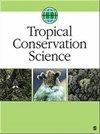利用当地知识和占用方法确定玻利维亚拉巴斯圣布埃纳文图拉-伊夏马斯公路沿线的野生动物走廊
IF 1.6
4区 环境科学与生态学
Q2 BIODIVERSITY CONSERVATION
引用次数: 1
摘要
2013年,我们对玻利维亚沿San Buenaventura Ixiamas公路的中大型哺乳动物的存在、分布和占用情况进行了基线研究,该公路与Madidi国家公园和综合管理自然区边界平行,穿过Tacana土著领地和一些邻近的私人财产。建立3 我们研究了一个865 平方公里面积划分为1 km2细胞,并对这些细胞中的356个进行采样。在每个细胞中,我们建立了一个300 m样条,分为25条 m剖面和已登记的野生动物标志,主要是脚印,来自八个野生动物物种或物种群。横断面沿着溪流(75%的细胞)或森林(25%的细胞)放置。使用单季单物种占有率模型,我们估计了土锥虫的占有率(ψ) = 0.39),Pecari tajacu(ψ = 0.5),Mazama americana(ψ = 0.56),Dasyprocta spp.(ψ = 0.59),宽楔楔(ψ = 0.56)、Leopardus spp.(ψ = 0.33),并用于Tayasu pecari(ψ = 0.17)和Panthera onca(ψ = 0.11)。占用和使用结果验证了Madidi及其影响区域之间的社区感知野生动物走廊。我们沿着许多穿过圣布埃纳文图拉-伊克西玛斯公路的溪流确定了额外的走廊。这种连通性不仅对野生动物很重要,而且从粮食安全的角度来看,对依赖野生动物作为重要蛋白质来源的土著社区也很重要。研究结果将用于通过确定维持马迪迪与周围景观连通性的优先区域来减轻道路改善的影响。本文章由计算机程序翻译,如有差异,请以英文原文为准。
Identifying Wildlife Corridors Using Local Knowledge and Occupancy Methods along the San Buenaventura-Ixiamas Road, La Paz, Bolivia
In 2013, we conducted a baseline study on the presence, distribution and occupancy of medium- to large-sized mammals in Bolivia along the San Buenaventura-Ixiamas road that runs parallel to the Madidi National Park and Natural Area of Integrated Management boundary and cuts through the Tacana Indigenous Territory and a number of neighboring private properties. Establishing a 3 km buffer on each side of the road, we studied an 865 km2 area divided into 1 km2 cells and sampled a total of 356 of these cells. In each cell, we established one 300 m transect divided into 25 m sections and registered wildlife sign, mainly footprints, from eight wildlife species or species groups. The transects were placed either along streams (75% of cells) or within forest (25% of cells). Using single-season single-species occupancy models we estimated occupancy (ψ) for Tapirus terrestris (ψ = 0.39), Pecari tajacu (ψ = 0.5), Mazama americana (ψ = 0.56), Dasyprocta spp. (ψ = 0.59), Cuniculus paca (ψ = 0.56), Leopardus spp. (ψ = 0.33), and use for Tayassu pecari (ψ = 0.17) and Panthera onca (ψ = 0.11). Occupancy and use results verified community perceived wildlife corridors between Madidi and its area of influence. We identified additional corridors along many streams crossing the San Buenaventura-Ixiamas road. This connectivity is not only important for wildlife, but also from a food security perspective for the indigenous communities that depend on wildlife as an important source of protein. The results will be used to mitigate the impact of road improvements through the identification of priority areas for maintaining connectivity between Madidi and the surrounding landscape.
求助全文
通过发布文献求助,成功后即可免费获取论文全文。
去求助
来源期刊

Tropical Conservation Science
BIODIVERSITY CONSERVATION-
CiteScore
3.60
自引率
5.90%
发文量
16
审稿时长
>12 weeks
期刊介绍:
Tropical Conservation Science is a peer-reviewed, open access journal that publishes original research papers and state-of-the-art reviews of broad interest to the field of conservation of tropical forests and of other tropical ecosystems.
 求助内容:
求助内容: 应助结果提醒方式:
应助结果提醒方式:


